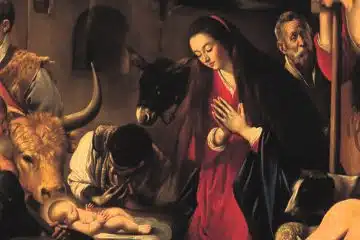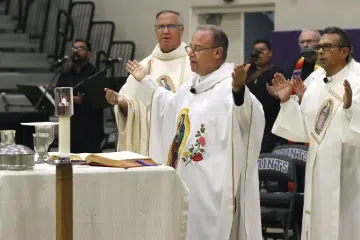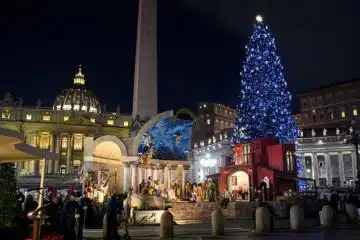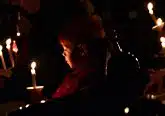He’s Here: Hope Made Flesh
In a visually saturated world, it’s easy to feel overwhelmed and become desensitized to beauty. Visio Divina, Latin for “divine seeing,” encourages us to slow down and engage in visual contemplation, using art as a profound tool for connecting with the Divine.
A Guide to Visio Divina
Begin by making the sign of the cross and inviting the Holy Spirit to guide your contemplation. Spend a moment meditating on the Adoration of the Shepherds (ca. 1613), painted by Juan Bautista Maíno. This work is located at The State Hermitage Museum in St. Petersburg, Russia. His original painting, mentioned in the Background below, is part of a series and located at the Museo del Prado. Then read Luke 2:8-20.
Background
Little is known about the Spanish Baroque artist, Juan Bautista Maíno—the Museo del Prado even calls him “one of the most unknown masters of Spanish painting.” Only about forty of his works are known today, yet each reveals an artist of remarkable skill and faith.
Born in 1581 in Pastrana, Spain, Maíno was the son of a fabric merchant and a Portuguese noblewoman. The family grew up near the royal court, serving Ana de Mendoza, who was the Princess of Eboli and the Duchess of Pastrana. In his later years, Maíno became a drawing teacher to the future King Philip IV.
Around 1600, Maíno traveled to Italy to study the leading artistic styles and techniques of his time. There, he absorbed influences from both Caravaggio’s naturalism and the Bolognese classicism—two schools whose contrasts of light, emotion, and order later merged uniquely in his own work.
Returning to Spain around 1611, he settled in Toledo, where, in 1612, he received a major commission to paint an altarpiece for the Dominican monastery of San Pedro Mártir. The collection contained salvific scenes from Scripture—one being the Adoration of the Shepherds. Although the contract specified an eight-month timeline, the work extended far beyond that. In 1613, before the paintings were complete, Maíno entered the Dominican order—delaying the commission’s progress but profoundly deepening his spirituality and artistic vision.
Intriguingly, the version of the Adoration of the Shepherds now housed in the Hermitage Museum is not identical to the Toledo original. Though similar in composition, the Hermitage painting feels more intimate and luminous. Scholars believe it was created around 1613, perhaps as a replica for another patron or as a work of private devotion.
Enter In
On a cool night, within a dusty stable, the Son of God is born and laid in a feeding trough cushioned with hay. The sky breaks open with light as overjoyed angels musically pour out from the clouds. Joseph gazes quietly in awe at the miracle before him. Mary looks down at the Newborn, hands clasped, with a faint smile. Soon, others accompany them. Out in the fields, shepherds hear the news from an angel and hurry toward the stable, hearts pounding with curiosity at this strange and glorious surprise. When they arrive, they see the message was true. One shepherd stands off to the side on the right, looking upon the manger. The other lies down on the ground, holding onto the sheep.
When looking at Maíno’s Adoration of the Shepherds, we notice that the visitors gathered around the manger are not all shepherds. In fact, only two shepherds appear among the other visitors who seem oddly out of place in the humble stable. These other four men are well-dressed, composed, and dignified. On the far left, two exchange glances just beyond the Christ Child; another kneels at the center in reverent adoration; and an elderly man on the far right meets the viewer’s gaze directly. These men don’t appear to be shepherds at all, but rather Maíno’s own reimagining of the Nativity. Drawing from Caravaggio’s naturalism, he portrays these visitors as contemporary Spanish noblemen. With their finely detailed features and elegant dress, they may represent specific patrons—or perhaps, simply models who posed for the artist.
Why would Maíno include such figures in a scene meant to honor the humble adoration of the shepherds? It was a deliberate decision. Like Caravaggio, Maíno uses contemporary dress or figures within a sacred moment to draw the viewer closer—to make the mystery of the Incarnation feel immediate and familiar. Yet, he seems to take it a step further, blending the real with the ideal. The nobleman on the far right meets our gaze directly, breaking the fourth wall and inviting us to enter the scene. He seems to be asking us: Where would you find yourself among them?
Maíno also painted what he knew. Raised around the royal court and later transformed by his vocation as a Dominican friar, he understood both worlds—the luxury of the nobility and the simplicity of religious life. Perhaps through this contrast, he reveals that humility transcends class, and that before Christ, all are invited to kneel and adore. Even the animals in the scene turn toward the manger, caught in quiet wonder and reverence. Truly, all are invited to delight in the Lord.
But amid these finely dressed visitors are the two shepherds who quietly anchor the scene. Their presence—rough, grounded, and almost overlooked—reminds us of who first received the good news. Bishop Barron cautions us not to romanticize the shepherds, explaining that they “were considered rather shady characters … unable to hold down a steady job, unreliable, and dishonest. So questionable was their reputation that their testimony was inadmissible in a court of law” (The Word on Fire Bible: The Gospels, 310). And yet, despite their untrustworthy reputation, it was to them that God sent an angel—proclaiming the good news and inviting them to witness His birth.
If we look closely, the shepherds do not appear overjoyed, which may feel unusual for an adoration scene. Their faces are mostly hidden, leaving us to read their emotions solely from posture and gesture. One leans on his staff toward the manger, making direct eye contact with Jesus. Though he stands further away than the kneeling nobleman, his response is no less sincere. He looks at Jesus in quiet awe. It is unclear what he is holding. It appears to be fur—perhaps a blanket for Mary or Jesus if the night grows cold.
The other shepherd lies across the foreground in front of the manger. His face is completely hidden; his bare feet are caked with dirt from his day’s work. At first glance, he does not appear joyful, but tired and worn. Notice how he reaches for the lambs—it’s as if he embraces them out of longing for comfort or a desire to protect. Beside him rests a basket of eggs and two lifeless birds—likely humble gifts for the Holy Family. The eggs, fragile yet full of life, speak of new life found in the Incarnation. Yet in this simple still life, Maíno weaves together both the Nativity and the Passion—the beginning already shadowed by the Cross. The still birds echo the sacrifice to come, while the eggs whisper a promise of a resurrection. The shepherd’s weary embrace of the lambs feels like a quiet knowing, as if he senses what lies ahead for the Lamb of God. His posture speaks not of sorrow, but exhaustion turned to peace—the relief of one who has waited long for a promise fulfilled.
Reflection
When contemplating Maíno’s Adoration of the Shepherds, we see what happens when our hope is finally fulfilled—how God keeps His promises. We learn that joy is the fruit of fulfillment, yet that joy does not always look like the exuberant angels. Sometimes it takes a very human form. Fulfilled hope can appear still and grateful, like Mary, who seems to whisper through exhaustion and relief, “He’s here.” It can look like the shepherd standing quietly in awe, or like the shepherd lying down, resting in Jesus’ presence.
Advent is a time of waiting and longing, but also a time of remembering that God keeps His promises. Maíno’s painting invites us to rest in that fulfilled hope—the quiet peace of Christ made present among us. ✣
 Emma Cassani is the graphic designer behind The Catholic Telegraph and author of Divine Seeing, which earned first place for Best Column in Arts & Leisure from the Catholic Media Association in 2025.
Emma Cassani is the graphic designer behind The Catholic Telegraph and author of Divine Seeing, which earned first place for Best Column in Arts & Leisure from the Catholic Media Association in 2025.
This article appeared in the December 2025 edition of The Catholic Telegraph Magazine. For your complimentary subscription, click here.
















![The night is advanced, the day is at hand. Let us then throw off the works of darkness [and] put on the armor of light Romans 13:12 Rorate Mass Old St Mary (CT Photo/Greg Hartman)](https://www.thecatholictelegraph.com/wp-content/uploads/2018/12/DSC_0569a-165x116.jpg)